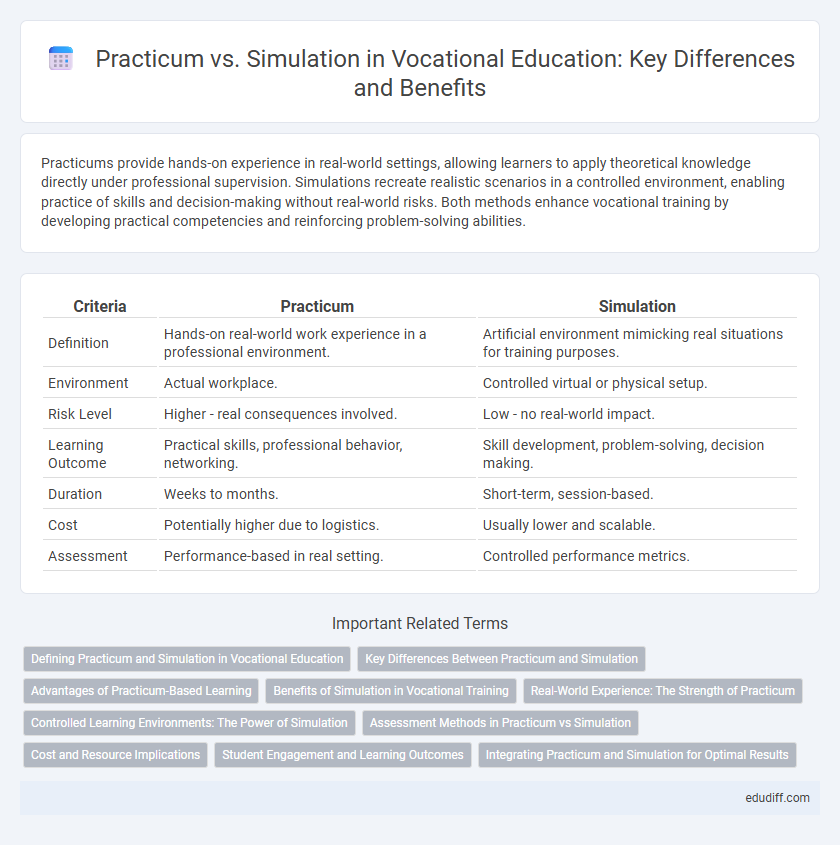Practicums provide hands-on experience in real-world settings, allowing learners to apply theoretical knowledge directly under professional supervision. Simulations recreate realistic scenarios in a controlled environment, enabling practice of skills and decision-making without real-world risks. Both methods enhance vocational training by developing practical competencies and reinforcing problem-solving abilities.
Table of Comparison
| Criteria | Practicum | Simulation |
|---|---|---|
| Definition | Hands-on real-world work experience in a professional environment. | Artificial environment mimicking real situations for training purposes. |
| Environment | Actual workplace. | Controlled virtual or physical setup. |
| Risk Level | Higher - real consequences involved. | Low - no real-world impact. |
| Learning Outcome | Practical skills, professional behavior, networking. | Skill development, problem-solving, decision making. |
| Duration | Weeks to months. | Short-term, session-based. |
| Cost | Potentially higher due to logistics. | Usually lower and scalable. |
| Assessment | Performance-based in real setting. | Controlled performance metrics. |
Defining Practicum and Simulation in Vocational Education
Practicum in vocational education refers to supervised, hands-on work experience where students apply theoretical knowledge in real-world job settings, enhancing practical skills and professional competence. Simulation involves creating realistic virtual or controlled environments that mimic actual workplace scenarios, allowing learners to practice tasks and problem-solving without real-world risks. Both methods are essential for skill development, with practicum emphasizing direct experience and simulation providing safe, repeatable training opportunities.
Key Differences Between Practicum and Simulation
Practicum involves hands-on, real-world experience in a workplace setting, providing direct exposure to professional tasks, while simulation uses virtual or controlled environments to mimic real-world scenarios for safe skill development. Practicum emphasizes actual fieldwork with live client interactions, whereas simulation prioritizes risk-free experimentation and repeated practice through technology-based models. The key differences lie in the level of practical engagement and the nature of the learning environment, affecting readiness and confidence in vocational skills.
Advantages of Practicum-Based Learning
Practicum-based learning offers hands-on experience in real workplace settings, enhancing practical skills and professional competence more effectively than simulations. It fosters direct interaction with industry tools, clients, and collaborative teams, promoting deeper understanding and adaptability. Employers often value practicum experience as it demonstrates a student's ability to apply theoretical knowledge in authentic vocational tasks, improving job readiness.
Benefits of Simulation in Vocational Training
Simulation in vocational training offers immersive, risk-free environments that enhance skill acquisition and confidence by replicating real-world scenarios. It provides consistent, repeatable practice opportunities, enabling learners to refine techniques without the consequences of errors that may occur during practicum. Advanced simulation technologies incorporate interactive feedback and performance analytics, accelerating competency development and improving overall training efficacy.
Real-World Experience: The Strength of Practicum
Practicum offers unparalleled real-world experience by immersing students directly in professional environments, enabling hands-on application of skills and immediate feedback from industry experts. Unlike simulation, which replicates scenarios in controlled settings, practicum fosters authentic interactions and problem-solving under actual workplace conditions. This experiential learning strengthens practical competencies and prepares students more effectively for career challenges.
Controlled Learning Environments: The Power of Simulation
Controlled learning environments in vocational training leverage simulations to replicate real-world scenarios, enhancing skill acquisition without the risks of actual practice. Simulations provide immersive, interactive experiences that adapt to learner responses, fostering critical thinking and problem-solving. Unlike practicums, which depend on variable real-world settings, simulations ensure consistent, measurable outcomes and safe error correction.
Assessment Methods in Practicum vs Simulation
Assessment methods in practicum emphasize real-world performance evaluation through direct observation, hands-on tasks, and reflective journaling, enabling instructors to measure practical skills and professional behavior in authentic settings. Simulation assessments utilize scenario-based tests, virtual environments, and controlled skill drills that provide standardized, repeatable conditions to evaluate decision-making, technical proficiency, and problem-solving without risk to real patients or equipment. Both methods integrate performance checklists and competency rubrics, but practicum leans toward holistic evaluation in natural contexts, whereas simulation prioritizes precision and safety in skill acquisition.
Cost and Resource Implications
Practicum involves real-world work environments, often requiring access to physical locations, equipment, and supervision, which can increase costs related to transportation, materials, and personnel. Simulation offers a cost-effective alternative by using virtual scenarios and software, reducing the need for physical resources and allowing scalable training without additional material expenses. Both methods demand upfront investment, but simulations typically lower long-term operational costs while ensuring consistent learning experiences.
Student Engagement and Learning Outcomes
Practicum offers hands-on, real-world experience that enhances student engagement by immersing learners in authentic vocational settings, promoting practical skill development and critical thinking. Simulation provides a controlled, risk-free environment where students can repeatedly practice tasks, improving confidence and mastery of specific competencies. Both methods significantly impact learning outcomes by catering to different aspects of skill acquisition and reflective learning in vocational education.
Integrating Practicum and Simulation for Optimal Results
Integrating practicum and simulation in vocational training enhances skill acquisition by combining real-world experience with controlled, risk-free environments. Practicum provides hands-on exposure to authentic tasks, while simulation allows repetitive practice and immediate feedback, accelerating competency development. Blending both methods optimizes learning outcomes, ensuring readiness and confidence in professional settings.
Practicum vs Simulation Infographic

 edudiff.com
edudiff.com